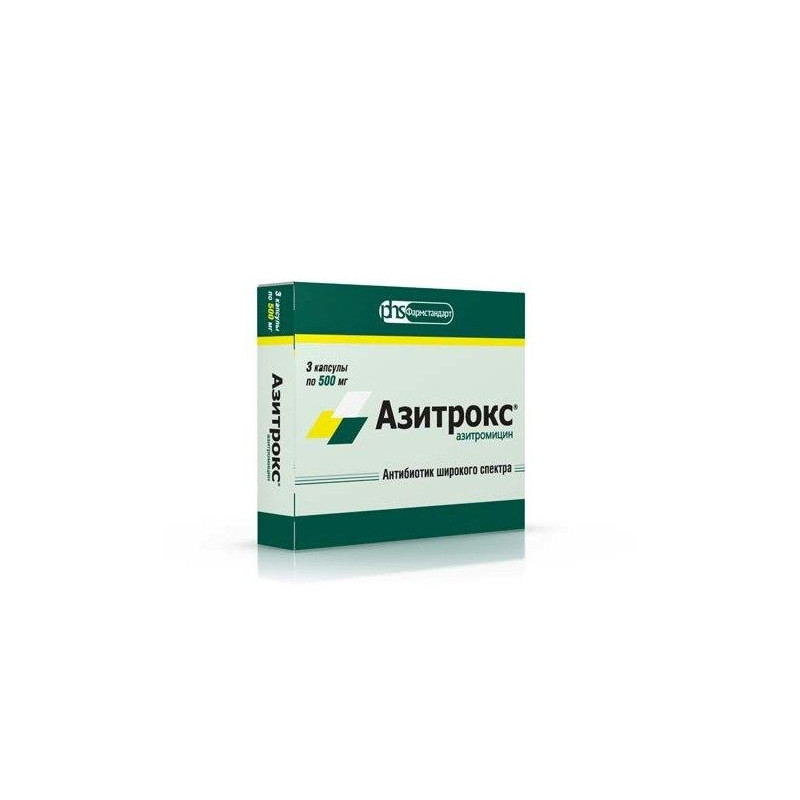



 All payments are encrypted via SSL
All payments are encrypted via SSL
 Full Refund if you haven't received your order
Full Refund if you haven't received your order
Infectious and inflammatory diseases caused by microorganisms sensitive to the drug:
- infections of the upper respiratory tract and upper respiratory tract (including tonsillitis, sinusitis, tonsillitis, otitis media);
- scarlet fever;
- infections of the lower respiratory tract (including bacterial and atypical pneumonia, bronchitis);
- infections of the skin and soft tissues (including erysipelas, impetigo, secondary infected dermatosis);
- infections of the urogenital tract (including urethritis and / or cervicitis);
- Lyme disease (borreliosis) in the initial stage (erythema migrans);
- diseases of the stomach and duodenum associated with Helicobacter pylori (as part of combination therapy).
Gastrointestinal: diarrhea (5%), nausea (3%), abdominal pain (3%); 1% - dyspepsia, flatulence, vomiting, melena, cholestatic jaundice, increased activity of hepatic transaminases; children have constipation, anorexia, gastritis. Possible candidomycosis of the oral mucosa.
Cardiovascular: feeling of heartbeat, chest pain (≤1%).
From the side of the central nervous system: dizziness, headache, drowsiness; in children - headache (in the treatment of otitis media), hyperkinesia, anxiety, neurosis, sleep disorders (≤1%).
From the reproductive system: ≤1% - vaginal candidiasis.
Urogenital: ≤1% - jade.
Dermatologic: in some cases - rash, photosensitivity.
Allergic reactions: rash, itching, angioedema, urticaria, conjunctivitis.
Other: increased fatigue.
- liver failure;
- renal failure;
- Children weighing less than 45 kg (for capsules 500 mg);
- children's age up to 12 years;
- Hypersensitivity to macrolide antibiotics.
WITH caution the drug should be used for arrhythmias (ventricular arrhythmias are possible, prolongation of the QT interval) in children with severe impaired liver or kidney function.
The use of the drug during pregnancy is possible only in the case when the intended benefit to the mother exceeds the potential risk to the fetus.
If necessary, the use of the drug during lactation should decide on the termination of breastfeeding.
Application for violations of the liver
The drug is contraindicated in severe violations of the liver.
Application for violations of kidney function
The drug is contraindicated in severe renal impairment.
Use in children
Contraindicated: children under 12 years.
Azitrox® should not be taken with food.
In the case of skipping the next admission, the missed dose should be taken as soon as possible, and subsequent ones - with an interval of 24 hours.
You must observe a break of at least 2 hours between taking Azitrox and antacids.
After discontinuation of treatment, hypersensitivity reactions may persist in some patients, which requires specific therapy under medical supervision.
Symptoms: with the use of the drug in high doses may increase side effects - severe nausea, temporary hearing loss, vomiting, diarrhea.
Treatment: gastric lavage, the appointment of Activated carbon, conducting symptomatic therapy.
Antacids (aluminum and magnesium), ethanol and food slow down and reduce the absorption of Azithromycin.
Azithromycin does not bind to the cytochrome P450 isoenzymes. Unlike most macrolides, azithromycin does not interact with theophylline, terfenadine, Carbamazepine, triazolam, Digoxin.
Macrolides (except azalides) slow excretion and increase plasma concentrations and toxicity of cycloserine, anticoagulants, methylprednisolone, felodipine, as well as preparations suffer from microsomal oxidation (carbamazepine, terfenadine, cyclosporine, hexobarbital, ergot alkaloids, valproate, disopyramide, Bromocriptine, phenytoin, oral hypoglycemic agents, xanthine derivatives, including theophylline), due to inhibition of microsomal oxidation in hepatocytes, while azalides such interaction to date have been noted.
With simultaneous use of azithromycin with digoxin, an increase in the concentration of the latter is observed.
With the simultaneous appointment of Warfarin and azithromycin (in usual doses), no changes in the prothrombin time have been identified, however, given that the interaction of macrolides and warfarin may increase the anticoagulant effect, patients need careful control of the prothrombin time.
With simultaneous use of azithromycin with ergotamine and dihydroergotamine, their toxic effects (vasospasm, dysesthesia) are enhanced.
With simultaneous use of azithromycin with triazolam, clearance decreases and the pharmacological action of triazolam is enhanced.
Lincosamines reduce the effectiveness of azithromycin.
Tetracycline and chloramphenicol enhance the effectiveness of azithromycin.
Pharmaceutical incompatibility
Azithromycin is pharmaceutically incompatible with Heparin.
Pharmacy sales terms
Storage conditions
List B. The drug should be stored out of the reach of children, dry, protected from light, at a temperature of 15 ° to 25 ° C.
